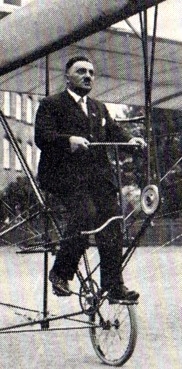- Engelbert Zaschka
Infobox Person
name =Engelbert Zaschka

image_size =250
caption =Engelbert Zaschka and his human powered glider during 1934
birth_name =
birth_date =1896
birth_place =Freiburg im Breisgau
death_date =June 26, 1955
death_place =Freiburg im Breisgau
death_cause =
resting_place =
resting_place_coordinates =
residence =
nationality =flagicon|GER German
other_names =
known_for =
education =
employer =
occupation =Engineer
title = Chief Engineer, Chief Designer
salary =
networth =
height =
weight =
term =
predecessor =
successor =
party =
boards =
religion =
spouse =
partner =
children =
parents =
relatives =
website =
footnotes =Engelbert Zaschka (1896 in
Freiburg im Breisgau ,Germany –June 26 ,1955 in Freiburg im Breisgau, Germany) was a German chief engineer [Rolf Besser: Technik und Geschichte der Hubschrauber: Von Leonardo da Vinci bis zur Gegenwart. Bernard & Graefe Verlag, Bonn 1996, p. 65] , chief designer and inventor. [ [http://www.utdallas.edu/library/collections/speccoll/ltapdf/Rosendahl1.pdf The University of Texas at Dallas: "Vice Admiral Charles E. Rosendahl Collection - Biographical Information"] (See also:Charles E. Rosendahl )] Zaschka became one of the first Germanhelicopter pioneers. He is a striking representative of the "Rotationsflugzeug" (Rotary-Wing Airplane). [Engelbert Zaschka: "Drehflügelflugzeuge. Trag- und Hubschrauber." C.J.E. Volckmann Nachf. E. Wette, Berlin-Charlottenburg 1936, p. 57]Engineering Activities
Zaschka Helicopter
In 1927 [ [http://siris-thesauri.si.edu/ipac20/ipac.jsp?session=11P8B0B391935.82&profile=planes&uri=link=3100019~!26176~!3100001~!3100002&aspect=subtab13&menu=search&ri=2&source=~!sithesauri&term=Zaschka&index= Smithsonian National Air and Space Museum Washington: "Zaschka Helicopter (1927)"] ] Engelbert Zaschka of
Berlin built a helicopter, equipped with two rotors, in which agyroscope was used to increase stability and serves as an energy accumulator for agliding flight to make a landing. Gliding in this case means a straight descent. He wanted to develop an efficientpropeller drive. [Engelbert Zaschka: "Drehflügelflugzeuge. Trag- und Hubschrauber." C.J.E. Volckmann Nachf. E. Wette, Berlin-Charlottenburg 1936, p. 47] A swivelling propeller at the rear provided propulsion and rudder control. The machine was a combination of anautogyro and ahelicopter . The principal advantage of the machine, Zaschka says, is in its ability to remain motionless in the air for any length of time and to descend in a vertical line, so that a landing may be accomplished on the flat roof of a large house. In appearance, the helicopter does not differ much from the ordinarymonoplane , but the carryingwing s revolve around the body.Zaschka Human-powered aircraft
In 1934 [ [http://siris-thesauri.si.edu/ipac20/ipac.jsp?session=11P8B0B391935.82&profile=planes&uri=link=3100019~!26176~!3100001~!3100002&aspect=subtab13&menu=search&ri=2&source=~!sithesauri&term=Zaschka&index= Smithsonian National Air and Space Museum Washington: "Zaschka Human-Power Aircraft (1934)"] ] he completed a large
human-powered aircraft , the "Zaschka Human-Power Aircraft". Zaschka constructed the large human-powered tractor monoplane with a narrow wing spanning about 66 feet (20 metres).Motorcycle and Zaschka Three-wheeler
From 1921 till 1925 the design department of "Orionette AG für Motorfahrzeuge" in Berlin [Otto Meibes: "Die Entwicklung der deutschen Automobilindustrie." Halle 1926, p. 166] , headed by Engelbert Zaschka, also produced some interesting unorthodox designs. [ [http://members.chello.nl/~wgj.jansen/text/orionette.html "Orionette" - Unfortunately the very desmodromic lay-out of this interesting two-stroke engine still remains secret. Source: Motorrad Heft 10/1971 and Tragatsch, E. : The Ill. Encyclopedia of motorcycles.] ]
Orionette is a historic Germanmotorcycle brand.In 1929 he invented a
three wheeled car , anautomobile which could be assembled quickly indomicile or set aside. [OLDTIMER MARKT (Oldtimer-Magazin), Heft 7/93, Artikel von Claudia Franke-Brandau: Parken im Wohnzimmer: Der zerlegbare Kleinwagen des Berliner Erfinders Engelbert Zaschka von 1929, page 206]His patents
*Patent|GB|272962|"Improvements in or relating to helicopter flying machines" issue date November 3, 1927
*US patent|1779524: "Helicopter" issue date October 28, 1930
*US patent|1944052: "Portable power plant" issue date January 16, 1934Publication
* Engelbert Zaschka: Drehflügelflugzeuge. Trag- und Hubschrauber. C.J.E. Volckmann Nachf. E. Wette, Berlin-Charlottenburg 1936.One of the first publications about helicopters. It is written in 1936 for airplane designers, as well as supporters of the rotary wing aircraft construction.
References
External links
*Smithsonian National Air and Space Museum Washington: [http://siris-thesauri.si.edu/ipac20/ipac.jsp?session=11P8B0B391935.82&profile=planes&uri=link=3100019~!26176~!3100001~!3100002&aspect=subtab13&menu=search&ri=2&source=~!sithesauri&term=Zaschka&index= Zaschka]
*„All the worlds Rotorcraft": [http://avia.russian.ee/helicopters_eng/germany.html Helicopters built in Germany before 1945]
* [http://de.wikipedia.org/wiki/Engelbert_Zaschka German Wikipedia (German)]Article
* [http://select.nytimes.com/gst/abstract.html?res=F10D15FD3E5F147A93C6A9178DD85F438285F9 “Says His Helicopter Can Halt in Flight; Midair Transfer of Passengers Predicted“] ,The New York Times , June 4, 1927.
* [http://pqasb.pqarchiver.com/washingtonpost_historical/access/119677076.html?dids=119677076:119677076&FMT=ABS&FMTS=ABS:FT&date=JUN+06%2C+1927&author=&pub=The+Washington+Post&desc=AIR+FLIVVERS.&pqatl=google Air Flivvers] ,The Washington Post , June 6, 1927.Pictures
* [http://www.history-of-aviation.com/poster/1919-1932/POSTER-C-ZAS-HELI-01/artwork/images/img_aviation_poster_large.jpgIng. Engelbert Zaschka and his remote controlled Helicopter Drone (Berlin-Tempelhof, 1928)]
* [http://www.history-of-aviation.com/poster/1919-1932/POSTER-C-ZAS-HELI-02/artwork/images/img_aviation_poster_large.jpgIng. Zaschka and his helicopter (Berlin-Tempelhof, 1928)]
* [http://images.fotosearch.com/bigcomps/IDX/IDX034/395412.jpgThe "Zaschka Human-Power Aircraft" (1934)]
Wikimedia Foundation. 2010.
